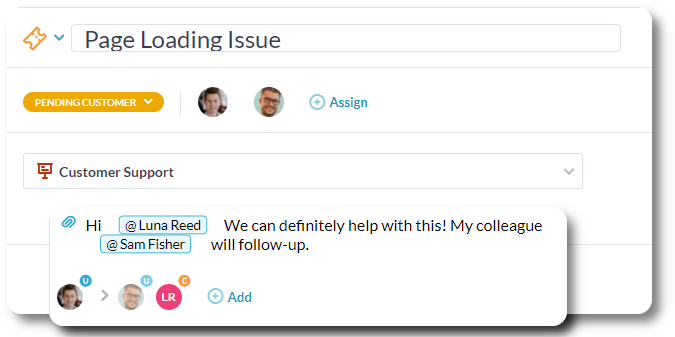A bug tracking tool allows testing and development teams to record and track bugs in their software. Log, track, and monitor bugs, automate processes, and communicate with your team and customers with OneDesk’s robust set of features.
Benefits of bug tracking with OneDesk
- Allows for a central repository of issues including all related documentation and communication.
- Enables streamlined collaboration and communication on issues with teammates or customers.
- Easily assign bugs to the right testers and developers.
- Simple prioritization and escalation of bugs.
- Track and monitor bugs with an organized, filterable, and searchable dashboard.
- Versatile automation capabilities.
- Flexible workflow and dashboard customization.
- Plan tasks, projects, and releases from the same application.
Why OneDesk for bug tracking?
OneDesk provides the unique capability of a bug tracking and ticketing tool as well as project management. What does this mean for bug tracking? Well it means that you can log and track bugs, as well as plan development tasks, all in one application. Bugs can be logged from multiple channels, both from your team or your customers. At the same time, your team can also plan and track the entire development lifecycle. Both aspects of OneDesk are tightly integrated.
Here’s a few examples of how you can use OneDesk’s unique combination of bug tracking and project management:
- Create subtasks for bugs. Subtasks have a parent-child relationship to the bug, but are full featured tasks. This means subtasks can be assigned, moved, and prioritized separately to the bug. Subtasks are a great way for multiple devs or testers to work on parts of a bug fix.
- Escalate a bug into a task. Escalating a bug allows for project management functionality, such as planning and task scoring. All the documentation about the bug is retained of course!
- Separate your bugs from project tasks. Or, incorporate a bug fix into a future project or release.

Minimize silos
As mentioned above, bugs can be logged by your team or if you enable it, from your customers. Customers can submit bugs through email, live chat, webforms, or with any third party applications enabled through integrations. Team members can log bugs through these channels as well, or simply log them internally. All bugs logged in OneDesk have the capability of having attached, real-time conversations. Conversations can be sent to the customer who logged the bug, or conversations can be internal with your teammates. Conversations are directly attached to the bug, enabling in-context communication and reducing back-and-forth.
Enable visibility of bugs
OneDesk provides a friendly interface for bug tracking. Use the list view to see all your bugs and easily filter or sort by priority. Move bugs into folders or projects to create an organized structure with the tree view. Use the Kanban board view to see the status of each bug and drag and drop to change status. All views can be filtered, grouped, and saved to your liking.

Using OneDesk for bug tracking:
Capture and track bugs
Bugs can be created from multiple channels such as email or customer applications. Your customers can send any issues from email, chat, or webforms, and all necessary information is captured. The captured bug saves all relevant information. It can include the description, code snippets, links, screenshots, severity level, and more. Moreover, with OneDesk’s configurable bug tracking tool, you can also take in anything else you wish from customers, such as feature requests or project tasks. All bugs or requests can be escalated into project tasks, then planned and incorporated into a release. This is done by converting the bug ‘ticket’ into a task.
Assign, prioritize, and categorize bugs
Assign bugs to the appropriate team or team member. From your work view, you can easily see who is assigned to a bug, the bug’s status or progress, and the priority level. By keeping bugs in one place, everyone is on the same page and it ensures the most severe bugs are prioritized with ease. Bugs can be organized into projects and folders for easy categorization.
Shape your workflows
OneDesk’s bug tracking tool is configurable to fit your unique needs. Here are a few of the ways you can streamline your workflow with Onedesk:
- Automations – Versatile automations allow you to streamline your workflows and cut down on repetitive tasks. Automatically notify your team, assign a teammate, change a bug’s status, and much more.
- Item types – Create unique types of bugs, tasks, projects. Each type allows you to create unique workflows with distinct names, statuses, and automations.
- Lifecycle statuses – Create the optimal workflow with configurable statuses for bugs, tasks, and projects.
- Custom fields – Capture information specific to your team with custom fields. Each custom field has a name and data type.

More than just a bug tracking tool
OneDesk provides many comprehensive project management features. You can manage the full-lifecycle of your projects and releases.
- Use the Gantt chart to plan tasks or monitor progress and workload.
- Agile methodology – You can utilize the Kanban board, agile points, and other agile features to plan your development projects.
- Reporting and Analytics – View real-time analytics on burndown, velocity, bug types, workload, and much more.
